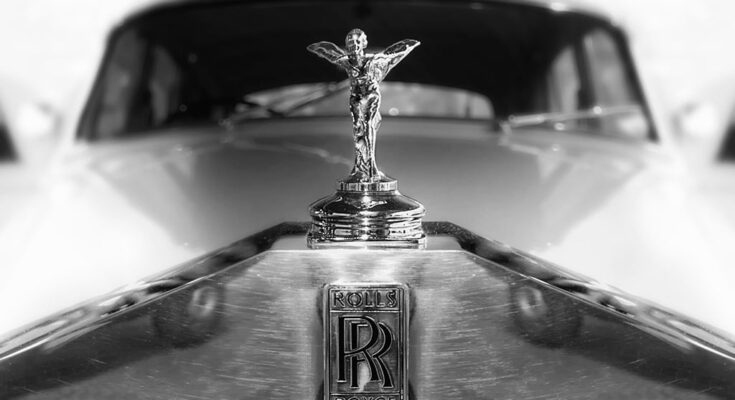
The Spirit of Ecstasy, the iconic mascot atop every Rolls-Royce, has roots in ancient Greek art. The emblem’s journey from the shores of Samothrace to the luxury car’s grille highlights the enduring influence of classical beauty on modern design.
Nike of Samothrace

The Spirit of Ecstasy, designed in 1911, draws heavily from the Nike of Samothrace, a Hellenistic masterpiece from around 190 BC. This dynamic sculpture celebrates Nike, the winged goddess of victory, as she descends from the heavens to crown naval victors.
The statue was originally displayed in the Sanctuary of the Great Gods on the island of Samothrace, a major religious site in ancient times. Like all statues from antiquity, the Nike would have been adorned with lavish colors to add to her realism.
Archaeological excavations have revealed that the Nike of Samothrace was placed on a large, tiered platform known as the “theater” or “monumental complex.”
This platform was situated on a hillside, facing the sea, allowing the statue to be dramatically visible to ships approaching the island.
The placement of the statue was highly strategic. Positioned on the stone prow of a ship, the Nike appears to be landing gracefully on the bow, her garments blown back by the wind.
The cliffside location amplified the sense of movement and dynamism, making the statue appear almost as if it were gliding down from the heavens.
The surrounding architectural elements, including a series of terraces and steps, further frame the statue, guiding visitors’ gazes upward toward Nike. A gaze that has swooned for millennia.
The Spirit of Ecstasy’s ancient inspiration
Claude Goodman Johnson, then Managing Director of Rolls-Royce, sought an emblem embodying elegance, power, and grace. A visit to the Louvre, where the statue now resides, inspired him.
He saw Nike’s powerful presence and flowing drapery, which seemed to capture movement and divine energy. This vision led him to create a figure for Rolls-Royce that would symbolize victory and the triumph of engineering and luxury.
The archaeological evidence of the statue’s placement on the cliffside, with its commanding view over the sea, inspired awe and reverence, much like Johnson intended the Spirit of Ecstasy to captivate and impress all who see it adorning a Rolls-Royce.
The story of the Rolls-Royce’s modern muse

Aside from a bygone beauty, a contemporary figure likewise influenced the ornament. Eleanor Velasco Thornton, who served as a model for the figure, had a close relationship with John Montagu, a motoring pioneer and friend of Johnson.
Her beauty and grace profoundly influenced Charles Robinson Sykes, the sculptor commissioned to create the Rolls-Royce mascot.
Thornton’s story adds depth to the mascot. Born into a modest London family, she worked as a model and actress before becoming Montagu’s secretary and confidante.
Their relationship, though passionate, remained a secret due to social constraints. Thornton tragically died when a torpedo hit the SS Persia during World War I. Montagu, who survived, mourned her silently, but her spirit lives on through the emblem.
The Spirit of Ecstasy blends ancient and modern influences. While its form echoes Nike’s classical beauty, its story intertwines with Thornton’s personal and poignant tale.
This blend of history and personal connection gives the mascot unique depth and lasting appeal.
The evolution of an icon

The Spirit of Ecstasy has undergone several transformations over the years. The original 1911 design stood nearly seven inches tall, with flowing robes and outstretched wings resembling the Nike of Samothrace.
This version captured both ancient Greek sculpture and the elegance of early 20th-century automotive design.
Rolls-Royce’s archives reveal that Sykes meticulously studied classical sculptures, ensuring his design embodied grace and movement. He wanted the figure to appear as if gliding through the air, much like the divine Nike.
In the 1970s, safety concerns led to a redesign. Rolls-Royce introduced a spring-loaded base that allowed the Spirit of Ecstasy to retract into the car’s radiator upon impact. This innovation addressed safety concerns while preserving the design’s artistic integrity.
The mechanism symbolized Rolls-Royce’s commitment to blending form with function, mirroring the ingenuity of ancient Greek engineering.
In 2020, Rolls-Royce introduced the Spirit of Ecstasy Expression, a digital redesign that simplified the figure’s lines.
This modern interpretation retained the elegance and fluidity of its ancient Greek origins, proving that classical beauty can adapt to contemporary needs.
How Nike inspired Rolls-Royce’s hood ornament
The Spirit of Ecstasy bridges the gap between ancient and modern art and engineering.
By drawing inspiration from the Nike of Samothrace, Rolls-Royce connects its brand to a legacy of excellence and timeless beauty. The mascot underscores that great design—elegance, power, and grace—remains universal and enduring.
The Nike of Samothrace not only celebrated a naval victory but also represented divine favor and human achievement.
Similarly, the Spirit of Ecstasy symbolizes not just a luxury car brand but the triumph of innovation, craftsmanship, and design. This connection between ancient art and modern luxury shows how the past continues to inspire and shape the future.



